| |
SOLAR RADIATION AND CLIMATE
OF THE EARTH |
|
V.
M. Fedorov*, N. K. Kononova**
Introduction The Sun is the main energy source for atmospheric processes (Voyeikov, 1903; Shuleikin, 1953; Kondratyev, 1965; Budyko, 1974; Monin, 1982). It is noted that the inequality of solar radiation income at different latitudes is the main cause of circulation processes in the atmosphere (Katz, 1960; Lorenz, 1970; Palme, Newton, 1973; Poghosyan, 1976; Gill, 1986). However, it is not yet thoroughly investigated despite the obvious connection between solar radiation and circulation processes. Typification schemes of atmospheric processes represent steady process of general atmospheric circulation in the form of interchanging stable repeated fragments. These are homogeneous processes that cover the whole hemisphere or vast territories. The following typifications of macroscaled atmospheric processes are most known in Russian meteorology: G. Y. Vangenheim A.A.Gierse (Vangenheim, 1935, 1952; Gierse, 1971, 1974), B.L. Dzerdzeevskiy, V.M. Kurganskaya, Z.M. Vitvitskaya (B.L. Dzerdzeevskiy and others, 1946). We use Dzerdzeevskiy-Kurganskaya-Vittvitskaya typification in this work, according to accurate formalization of circulation situations, time and space informativity (developed for the whole Northern hemisphere from 1899 up to present time) and general access to the Calender of elementary circulation mechanisms (ECM) rotation (http://www.atmospheric-circulation.ru; Kononova, 2009, 2014). This typification takes the correlation between zonal and meridional elements of circulation as a profile characteristic. There are 13 basic types of ECM and 28 variants of basic types based on seasonal or regional differences a total of 41 ECM types. ECMs are also united in 4 groups, according to the interrelation character of zonal and meridional transfers at extratropical latitudes of the Northern hemisphere (Table 1): zonal group (arctic invasions no blocking processes, 2 or 3 southern cyclone breaks in different sectors of the hemisphere, ECM 1 and 2 type); disturbance of zonal circulation group (one blocking process upon the hemisphere, from 1 to 3 southern cyclone breaks, ECM types 3-7); meridional northern group (from 2 to 4 simultaneous blocking processes, from 2 to 4 southern cyclones breaks, ECM types 8-12); meridional southern group (cyclonic circulation on the pole, no blocking processes, from 2 to 4 southern cyclone breaks, intruding Arctica, 13th ECM type)
Table 1. ECM differentiation
according to the transfer direction upon the Northern hemisphere
Z and ZD groups display zonal transfer in the atmosphere, NM and SM groups display meridional transfer of air masses. Thus, elementary circulation mechanisms, groups and seasons are differentiated in constant circulation process (B.L. Dzerdzeevskiy, 1975), being main structural elements of the presented typification. Time, frequency continuation of definite ECM actions reflect the peculiarities of general atmospheric circulation; determine the weather character for each concrete place. The continuity of actions of circulation groups, the interrelation character of zonal and meridional circulation forms are the most important macrocirculational characteristics during investigation of long-term climate changes. The solar radiation variations hitting the Earth are determined by two main reasons that have different physical nature. The researches of solar radiation variations connected with the alternation of the physical activity of the Sun have deep historic background. Existence of connection between the change of solar activity and climate is being discussed long period of time. (Absudamatov, 2009; Dergachev, 2009; Dudok de Wit, Watermann, 2010; Schurer et al., 2014). We dont concern the alteration of Sun activity in this work. We investigate the variations of solar flow connected with sky-mechanic processes (astronomic climate theory conceptions) on the long periods of time. We observe orbital elements, influenced by secular disturbance the longitude of perihelion and eccentricity and the slope of rotational axis of the Earth. These perturbations have considerable variation periods (Milankovitch 1939; Sharaf, Budnikova, 1968, Berger, Loutre, 1991; Monin, Shishkov , 2000). The calculations of incoming solar radiation in the range of periodical disturbance began in Vojekov Main Geophysical Observatory (Borisenkov et al.,1983, 1985). But there was no continuation of this research.
Methodology of calculations According to the incoming data of JPL Planetary and Lunar Ephemerides DE-405/406 (http://ssd.jpl.nasa.gov) we calculate the amounts of incoming solar radiation (in the absence of atmosphere) during tropical years, half years and seasons of the year in different latitude zones (5° latitude step) of Earth ellipsoid from 3000 BC up to 2999 A.D. The ephemerides accuracy according to the distance between the Earth and the Sun is 10-9 ΰ.u (or 0,1496 km), time accordancy 1 second (or 0,0000115 day). The surface of the Earth was approximated by ellipsoid (GRS80) with semi-axis 6378137 m (big ones) θ 6356752 m (small one). The calculations are based on the chain of formulas, the following being general among them:
where I
- incoming solar radiation for elementary n-period
of m tropical year (Joules);
Results and discussion
Correlational connection was investigated on the rows with time step of 100 years (secular interval) with shifting motion (1 year step) from the beginning of actual data massive (1899) up to present time (2013). Thus, the values of correlation coefficient (R) for intervals 1899-1998, 1900-1999 and so on, 16 secular intervals total (Fig. 1). It was found that high correlation between incoming solar radiation and difference in the incoming amount to equatorial and polar regions of the Northern hemisphere is found for two circulation groups: SM and ZD. Average R value of incoming radiation with ZD action time is 0.673, with SM action time 0.703. Average R value of radiation difference hitting equatorial and polar regions (showing interlatitudinal solar radiation gradient), with ZD action time comes to -0,635, with SM action time 0,756. ZD and SM response time upon incoming solar radiation (absence of atmosphere) and difference of solar radiation hitting equatorial and polar regions of the Northern hemisphere are contrary to each other. Stated that incoming solar radiation in modern era is reducing, and solar radiation difference hitting equatorial and polar regions is increasing, we can conclude that there is a certain tendency of decreasing the action time of ZD groups and increasing the action time of SM groups (Fedorov, 2014).
As it is stated on the graphs (Fig. 1) secular intervals are differentiated in the date massive (from 1911-2010 up to 1914-2013, 4 intervals in total. R is high and close for ZD groups (Table 2). Changes of R in these 4 secular intervals display 1.09% for ZD group (incoming radiation) and 1.31 (difference), for SM groups 1.25% and 1.03% accordingly. These secular intervals are uses as a basis for linear regression equations.
Table 2. Average values of solar radiation correlation coefficient and action time of circulation groups (probability 0.99). First column correlation with incoming solar radiation, second difference of solar radiation hitting equatorial and polar regions.
We calculated the values of ZD and SM action time (period from 1850 to 2050 ) These calculations were based on regression equations applied for authentic secular intervals (Fig. 2)
The resulting distributions reflect secular change tendencies in the action time of circulation groups, defined by a combination of precessional (about 25.7 thousand years) and nutational (19 years) cycles, regulating the incoming solar radiation upon the upper bound of the atmosphere (Fedorov, 2012, 2013, 2014). All calculated values of action time of circulation groups are characterized by high values of R actual time figures (for the period from 1899 to 2013). R is 0.747 for the SM group (for all valid secular intervals) and 0.715 for ZD group. A detailed comparison of calculated values of action time of circulation groups with actual action values (Fig. 3, 4) was conducted for the period 1899 2013 provided by the data presented in the Calendar of ECM sequential change (www.atmospheric-circulation.ru). The average value of action time (for this period) based on actual data for SM group is 47.2 days, based on calculated data 48.5. For a ZD group 89.5 and 91.9 days, respectively The average modulus discrepancy between actual and calculated action time values from 1899 to 201 is 23.1 days for SM group and 20.4 days for ZD group. This amounts 49.0% and 22.8% of the corresponding annual average values of the action time based on actual data. Also we conducted the calculations based on the regression equation in the form of a second degree polynomial. The correlation between calculated and actual values of the action time in secular intervals for SM 0.744, for ZD 0.742. Comparison of the calculated data with the actual data for interval from 1899 to 2013 shows that the approximation does not differ significantly from the linear in this case (the difference is significant at intervals of prediction and reconstruction). Thus, the average annual indicators of calculated data for the SM action time amounted 48.1 days (with an average annual time for actual numbers of 47.2 days), for ZD 90.8 days (89.5). The average annual difference for SM 23.0 days, for ZD 19.8 days. This is 48.8% and 22.1% of the average duration of corresponding actual series. In the case of a linear dependence SM action time could reach about 160 days in 2050, and ZD action time decrease close to zero. In the case of the quadratic dependence SM action time can increase to about 234 days, ZD group will not appear in the circulation process (Fig. 5). In relation to 2013 in the case of a linear dependence with solar radiation SM action time growth will be 90.6%, in case of a quadratic dependence 175.9%. The ZD action time will decrease by 100%.
Also we studied the dependence of action time of zonal (Z + ZD) and meridional (SM +NM) groups on the secular intervals. The ratio of the duration of these forms of circulation is the basic principle of typing circulation processes in the atmosphere (Dzerdzeevsky et al., 1946; Dzerdzeevsky, 1954, 1968). The action time of zonal and meridional circulation groups was compared to the incoming (in the absence of the atmosphere) solar radiation and the difference in solar radiation hitting the equatorial and polar regions of the Northern Hemisphere. R values of SM and NM groups opposed to difference are positive, opposed to the incoming radiation are negative. The average R value is 0.627 according to data array (from 1899 to 2013), with incoming radiation -0.665 (Fig. 6). R indicators of Z and ZD action time according to data array, on the contrary, opposed to the incoming radiation are positive (average is 0.631), opposed to difference negative (average of -0.593). The average R value for all secular intervals for the meridional circulation action time and the incoming radiation is -0.645. For the zonal circulation and incoming solar radiation the average of all secular intervals is positive and amounts 0.614. For reliable range R values increases to -0.725 and 0.703, respectively. According to regression equations for 4 reliable secular intervals (from 1911 - 2010 to 1914 2013) the action time values of zonal and meridional circulation for the interval from 1850 to 2050 were calculated. R of the actual action time compared to the calculated on the entire data array from 1899 to 2013 amounted 0.682 for the meridional circulation (SM. + NM.), 0.650 for zonal circulation (Z + ZD). The distribution of the calculated values is shown in Fig. 7. Comparison of actual and calculated values (Fig. 8, 9) is also carried out from 1899 to 2013 period (provided with actual data). Annual average of action time of the meridional circulation (SM + NM) on this interval is 244.1 days for the actual values and 239.3 days for the calculated values. For zonal circulation (Z + ZD these values are equal to 115.6 days and 120.4 days, respectively. The average annual divergence of actual and calculated values of action time for the meridional circulation is 28.3 days, for the zonal circulation - 27.9 days. This amounts 11.6% of the average action time of the meridional circulation and 24.1% of the average zonal circulation action time. Divergence of meridional and zonal circulation action time is characterized by the R value equal to -0.98.
Also, the calculations of the circulation action time on the basis of the regression equation in the form of a second degree polynomial were performed. Average numbers for the calculated values of the meridional circulation action time were found to be 241.8 days (actual 244.1), for the zonal circulation 118.1 days (actual 115.5). R of calculated values of action time with the actual values for the meridional circulation amounted to 0,741, for the zonal circulation to 0,712. The average annual divergence of actual and calculated action times of the meridional circulation is characterized by 25.5 days, zonal 25.1 days, which is 10.4% and 21.7% of the corresponding average action time of circulation. For the period from 2014 to 2050 values action time of the zonal and meridional circulation show that the meridional circulation will be essential predominate over the zonal circulation in the general circulation of the atmosphere. The minimum action time of meridional circulation in this interval will be close to 280 days, and the maximum action time of zonal will amount about 75 days. On the 2020-2030 a slight increase in the action time of zonal circulation and reduce in meridian circulation is expected (Fig. 10).
There is a reduction in divergences of series for calculated values of the action time of circulation groups considering the accumulation of solar radiation (the regression equation - second-degree polynomial) with actual values. Thus, the average deviation (in absolute value) for ZD group is reduced from 20 to 17 days, from 25 to 21 days for SN group, from 25v to 21 for zonal and meridional circulations. On average the reduction of the calculated values of the action time from the actual amounts approximately 3.5 days or 14.7% compared to the values obtained without taking into account the accumulation of solar radiation. R for actual and calculated (with the accumulation) values of the action time amounts 0,810 for ZD group, 0,821, for SM group, 0,795 for the zonal circulation (Z + ZD), and 0,823 for the meridional circulation (SM + NM). This values exceed the corresponding values of R obtained without taking into account accumulation on 9,3% (ZD), 10,2% (SM), 12,0% (Z + ZD) and 11,2% (SM + NM). Higher rates of connection duration of the action time of circulation groups, zonal and meridional circulation with accumulated solar radiation point to the accumulation of heat associated with the hitting solar radiation in the atmosphere and to the absence of radiative equilibrium in the world.
Conclusion 1) We determined the connection of incoming solar radiation and the difference between solar radiation hitting equatorial and polar regions of the Northern Hemisphere (in the absence of atmosphere) with the action time of the zonal (Z + ZD) and meridional (NM +SM) circulation, the ratio of which is a profiling feature in B .L. Dzerdzeevskiy typification. 2) The connection between incoming solar radiation and the difference between solar radiation coming upon the equatorial and the polar regions of the Northern Hemisphere (in the absence of the atmosphere), and the action time of individual groups of circulation (southern meridional and disturbance of zonal) is determined. 3) The different response character of zonal and meridional circulation action times and separate circulation groups (southern meridional and disturbance of zonal) on the change incoming solar radiation and the difference between solar radiation hitting the equatorial and polar regions of the Northern Hemisphere is identified. 4) We determined the connection of the actual time circulation groups (ZD and SM) and zonal (Z + ZD) and meridional (SM + NM) circulations with accumulated hitting solar radiation. Higher rates of connection duration of the action time of circulation groups point to the accumulation of heat in the atmosphere 5) We created the basics to forecast the action time of zonal and meridional circulation and separate groups of circulation (southern meridional and disturbance of zonal) in the Northern Hemisphere.
|
||||||||||||||||||||||||||||||
|
SOLAR RADIATION AND CLIMATE |
||
|
© www.solar-climate.com
|
|
|
||||||||||||||||||||||||||||||||||||||||||
|
|
|||
 ,
(1)
,
(1) 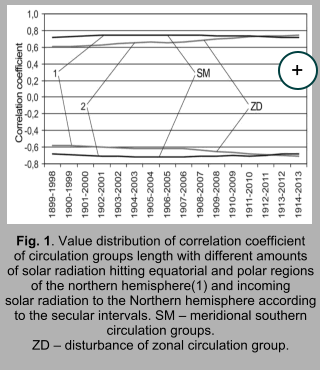 The calculated values of solar radiation hitting the surface of earth
ellipsoid in absence of atmosphere were juxtaposed to the action time
of circulation groups. (Kononova, 2009;
The calculated values of solar radiation hitting the surface of earth
ellipsoid in absence of atmosphere were juxtaposed to the action time
of circulation groups. (Kononova, 2009;
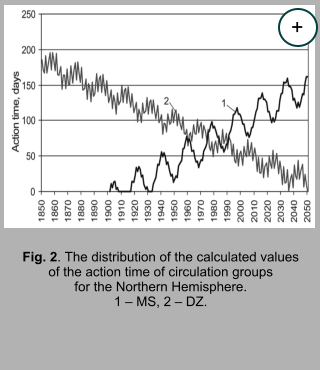
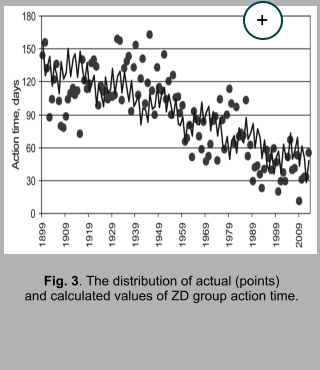
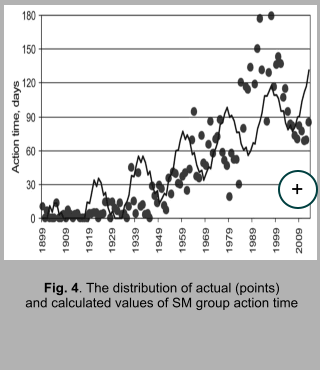
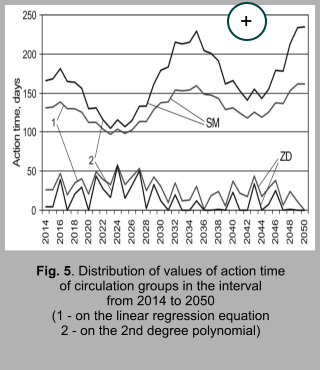
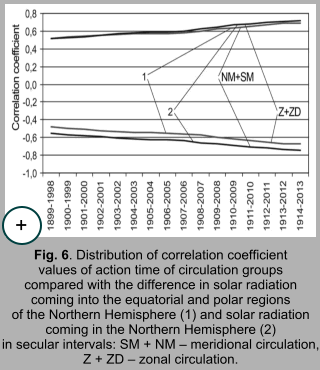
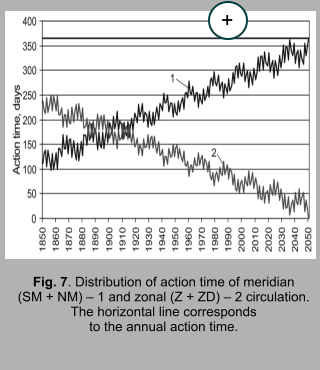
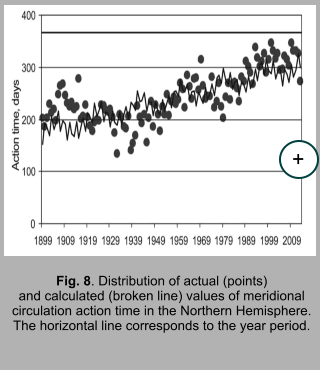
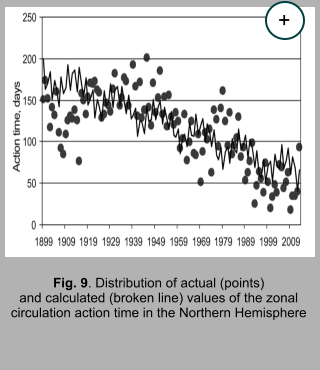
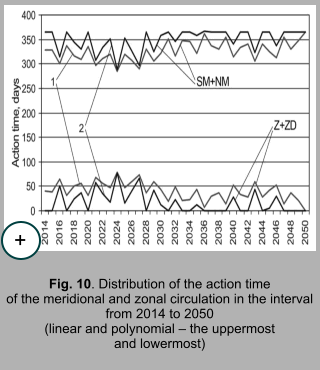 The values of accumulated solar radiation coming per year in the northern
hemisphere were performed (and accumulated difference between radiation
solar hitting equatorial and polar regions of the Northern Hemisphere).
For the beginning of the accumulation the second year in a series of
data was accepted. Values for it were calculated by adding the values
of the first year (1899) with the second year (1900). The values of
the third year were obtained by followed summing the values of the third
year with a sum of the previous two years, etc. Correlation analysis
series of the duration of circulation groups, zonal and meridional circulation
and accumulated hitting solar radiation reveals a marked increase in
R for the series from 1899 to 2013 concerning presented in Table. 2.
In this case, signs of R change to the opposite in comparison with the
obtained without taking into account the accumulation solar radiation
values of R. So, R values amounts -0.765 for the action time of ZD group
(action time with the accumulated hitting radiation and the accumulated
difference), 0.813 for the action time of SM group, -0.699 for zonal
circulation (Z + ZD), 0.733 for the meridional circulation. Increasing
of R values (accumulated solar radiation with the action time of circulation)
amounts 7.4% for ZD group, 13.2% for SM group, 10.8% for the zonal circulation
(Z + ZD), 16.9% for the meridional circulation (SM + NM). The corresponding
R values of the action time of circulation groups with accumulated hitting
radiation and difference have equal values and same signs.
The values of accumulated solar radiation coming per year in the northern
hemisphere were performed (and accumulated difference between radiation
solar hitting equatorial and polar regions of the Northern Hemisphere).
For the beginning of the accumulation the second year in a series of
data was accepted. Values for it were calculated by adding the values
of the first year (1899) with the second year (1900). The values of
the third year were obtained by followed summing the values of the third
year with a sum of the previous two years, etc. Correlation analysis
series of the duration of circulation groups, zonal and meridional circulation
and accumulated hitting solar radiation reveals a marked increase in
R for the series from 1899 to 2013 concerning presented in Table. 2.
In this case, signs of R change to the opposite in comparison with the
obtained without taking into account the accumulation solar radiation
values of R. So, R values amounts -0.765 for the action time of ZD group
(action time with the accumulated hitting radiation and the accumulated
difference), 0.813 for the action time of SM group, -0.699 for zonal
circulation (Z + ZD), 0.733 for the meridional circulation. Increasing
of R values (accumulated solar radiation with the action time of circulation)
amounts 7.4% for ZD group, 13.2% for SM group, 10.8% for the zonal circulation
(Z + ZD), 16.9% for the meridional circulation (SM + NM). The corresponding
R values of the action time of circulation groups with accumulated hitting
radiation and difference have equal values and same signs.



